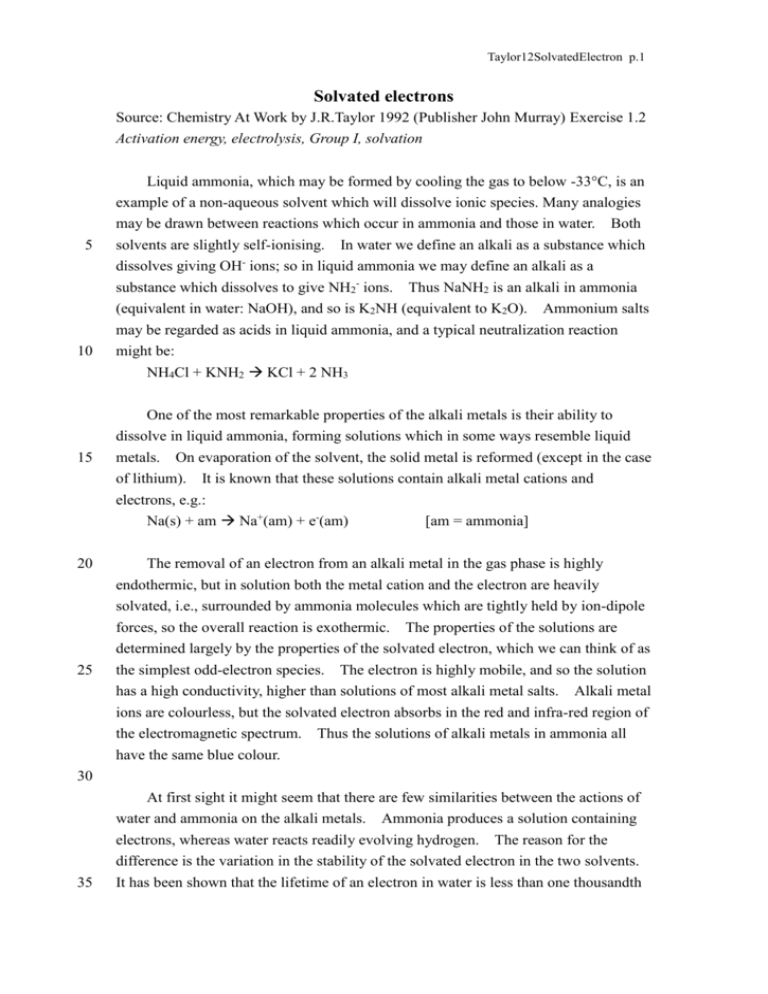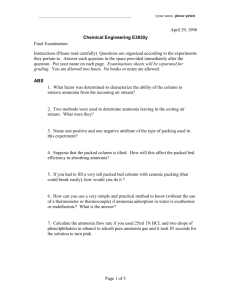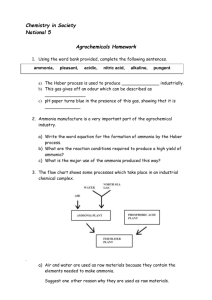Solvated electrons
advertisement

Taylor12SolvatedElectron p.1 Solvated electrons Source: Chemistry At Work by J.R.Taylor 1992 (Publisher John Murray) Exercise 1.2 Activation energy, electrolysis, Group I, solvation 5 10 15 20 25 Liquid ammonia, which may be formed by cooling the gas to below -33C, is an example of a non-aqueous solvent which will dissolve ionic species. Many analogies may be drawn between reactions which occur in ammonia and those in water. Both solvents are slightly self-ionising. In water we define an alkali as a substance which dissolves giving OH- ions; so in liquid ammonia we may define an alkali as a substance which dissolves to give NH2- ions. Thus NaNH2 is an alkali in ammonia (equivalent in water: NaOH), and so is K2NH (equivalent to K2O). Ammonium salts may be regarded as acids in liquid ammonia, and a typical neutralization reaction might be: NH4Cl + KNH2 KCl + 2 NH3 One of the most remarkable properties of the alkali metals is their ability to dissolve in liquid ammonia, forming solutions which in some ways resemble liquid metals. On evaporation of the solvent, the solid metal is reformed (except in the case of lithium). It is known that these solutions contain alkali metal cations and electrons, e.g.: Na(s) + am Na+(am) + e-(am) [am = ammonia] The removal of an electron from an alkali metal in the gas phase is highly endothermic, but in solution both the metal cation and the electron are heavily solvated, i.e., surrounded by ammonia molecules which are tightly held by ion-dipole forces, so the overall reaction is exothermic. The properties of the solutions are determined largely by the properties of the solvated electron, which we can think of as the simplest odd-electron species. The electron is highly mobile, and so the solution has a high conductivity, higher than solutions of most alkali metal salts. Alkali metal ions are colourless, but the solvated electron absorbs in the red and infra-red region of the electromagnetic spectrum. Thus the solutions of alkali metals in ammonia all have the same blue colour. 30 35 At first sight it might seem that there are few similarities between the actions of water and ammonia on the alkali metals. Ammonia produces a solution containing electrons, whereas water reacts readily evolving hydrogen. The reason for the difference is the variation in the stability of the solvated electron in the two solvents. It has been shown that the lifetime of an electron in water is less than one thousandth Taylor12SolvatedElectron p.2 of a second. It reacts as follows: e (aq) + H2O(l) OH-(aq) + ½ H2(g) - 40 45 We may therefore imagine the reaction of sodium with water as involving the formation of Na+ ions and electrons, followed by reaction of the electrons with the solvent. In contrast, the electron is stable almost indefinitely in ammonia if the solvent is pure, and so a metal solution is formed. If a suitable catalyst such as iron(III) oxide is added, however, then decomposition is rapid: e-(am) + NH3(l) NH2-(am) + ½ H2(g) which is precisely analogous to the reaction in water. The reaction of ammonia with the electron is energetically favourable, but in the absence of a suitable catalyst the activation energy is too high for the reaction to occur at a suitable rate. The catalyst reduces the activation energy by providing an alternative pathway, and decomposition then occurs rapidly. 50 Adapted from Odd Electron Species, P.R. Scott Cambridge University Press (1981) 55 Questions 1. Write equations for the self-ionization of water and ammonia. 2. Write an equation for the reaction of K2NH with ammonia. How is this analogous to the corresponding aqueous reaction? 3. 4. 60 5 65 6 7 70 What name is given to the removal of an electron in the gas phase? Give a precise definition, illustrating your answer with an equation for sodium. Explain the meaning of the terms a) odd-electron species; b) catalyst; c) activation energy Draw diagrams to illustrate the way in which a sodium cation and an electron become solvated, using four solvent molecules for each, clearly indicating the method of bonding. Draw a suitable energy level diagram for the processes which occur during the dissolution of sodium in liquid ammonia. What reactions, if any, will occur at the anode and cathode during the passage of an electric current through a solution of sodium in liquid ammonia? Is the author justified in referring to ‘conduction’ rather than electrolysis? [END]








